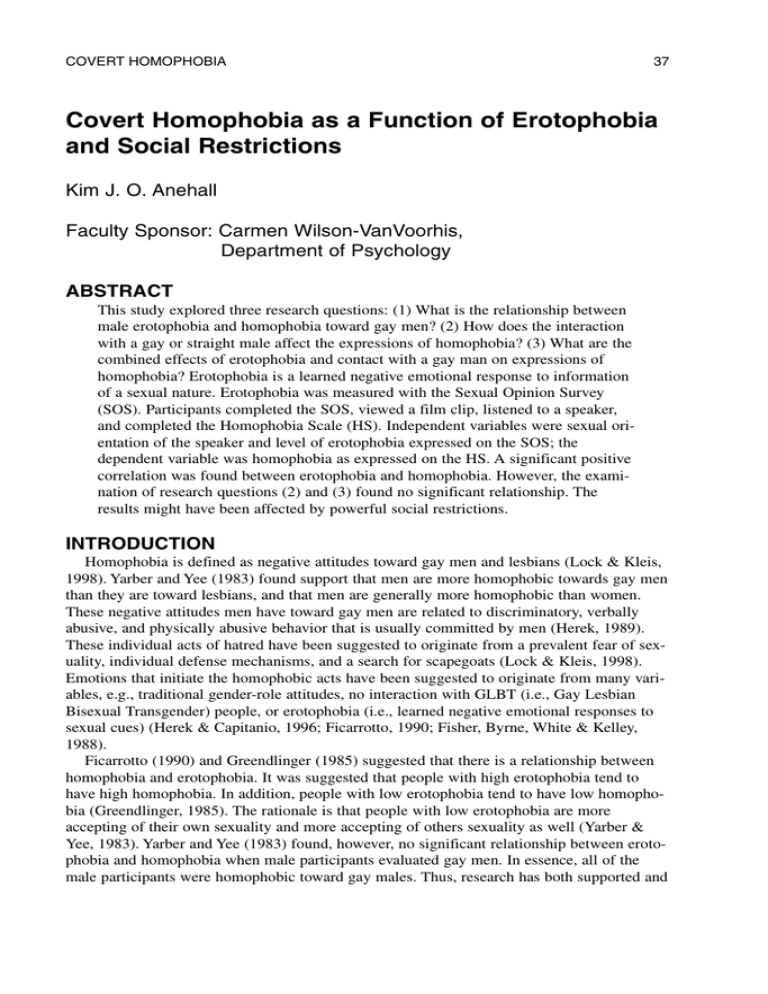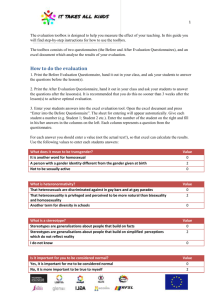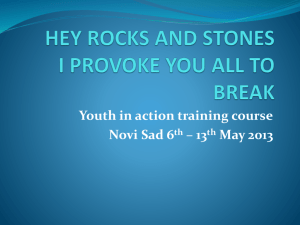
COVERT HOMOPHOBIA
37
Covert Homophobia as a Function of Erotophobia
and Social Restrictions
Kim J. O. Anehall
Faculty Sponsor: Carmen Wilson-VanVoorhis,
Department of Psychology
ABSTRACT
This study explored three research questions: (1) What is the relationship between
male erotophobia and homophobia toward gay men? (2) How does the interaction
with a gay or straight male affect the expressions of homophobia? (3) What are the
combined effects of erotophobia and contact with a gay man on expressions of
homophobia? Erotophobia is a learned negative emotional response to information
of a sexual nature. Erotophobia was measured with the Sexual Opinion Survey
(SOS). Participants completed the SOS, viewed a film clip, listened to a speaker,
and completed the Homophobia Scale (HS). Independent variables were sexual orientation of the speaker and level of erotophobia expressed on the SOS; the
dependent variable was homophobia as expressed on the HS. A significant positive
correlation was found between erotophobia and homophobia. However, the examination of research questions (2) and (3) found no significant relationship. The
results might have been affected by powerful social restrictions.
INTRODUCTION
Homophobia is defined as negative attitudes toward gay men and lesbians (Lock & Kleis,
1998). Yarber and Yee (1983) found support that men are more homophobic towards gay men
than they are toward lesbians, and that men are generally more homophobic than women.
These negative attitudes men have toward gay men are related to discriminatory, verbally
abusive, and physically abusive behavior that is usually committed by men (Herek, 1989).
These individual acts of hatred have been suggested to originate from a prevalent fear of sexuality, individual defense mechanisms, and a search for scapegoats (Lock & Kleis, 1998).
Emotions that initiate the homophobic acts have been suggested to originate from many variables, e.g., traditional gender-role attitudes, no interaction with GLBT (i.e., Gay Lesbian
Bisexual Transgender) people, or erotophobia (i.e., learned negative emotional responses to
sexual cues) (Herek & Capitanio, 1996; Ficarrotto, 1990; Fisher, Byrne, White & Kelley,
1988).
Ficarrotto (1990) and Greendlinger (1985) suggested that there is a relationship between
homophobia and erotophobia. It was suggested that people with high erotophobia tend to
have high homophobia. In addition, people with low erotophobia tend to have low homophobia (Greendlinger, 1985). The rationale is that people with low erotophobia are more
accepting of their own sexuality and more accepting of others sexuality as well (Yarber &
Yee, 1983). Yarber and Yee (1983) found, however, no significant relationship between erotophobia and homophobia when male participants evaluated gay men. In essence, all of the
male participants were homophobic toward gay males. Thus, research has both supported and
38
ANEHALL
rejected the relationship between homophobia and erotophobia. Consequently, it was essential to find more evidence to support or reject the relationship between erotophobia and
homophobia.
Research has suggested that social restrictions of expressing homophobia and the negative
feeling toward homosexuals often conflict. Social restrictions are situations where it is not
acceptable to express homophobia. People who are homophobic are reluctant to express their
homophobia in socially restricted situations, because they are afraid of negative accusations
(i.e., being called a bigot). Thus, in situations where contact with gay men occurs, creating
social restrictions will lead people who are homophobic to express positive bias toward gay
men in order to avoid being labeled as homophobic (Aberson, Swan & Emerson, 1999).
Little research has investigated how male erotophobes would react in situations where
contact with gay men occurs. Both Greendlinger (1985) and Ficarrotto (1990) suggested that
erotophobes are more homophobic. Aberson, et al. (1999), however, found that homophobes
changed their expressed attitude when there were social restrictions against expressing homophobia. Consequently, erotophobes might be more likely to change their expressed attitude in
situations where social restrictions limit the expression of homophobia.
This study focused on three research questions: (1) What is the relationship between male
erotophobia and homophobia toward gay men? Greendlinger (1985) suggested that individuals with high erotophobia express more homophobia than individuals with low erotophobia.
(2) How does the interaction with a gay or straight male affect the expressions of homophobia? Aberson, et al. (1999) found that individuals changed their results on a homophobia
scale in order to be perceived as non-biased in situations with gay men. (3) What are the
combined effects of erotophobia and contact with a gay man on expressions of homophobia?
Most studies have been focused on erotophobia and attitudes toward gay men (Yarber & Yee,
1983; Fisher, Byrne, White & Kelley, 1988; Ficarrotto, 1990), and not the actual contact with
gay men. It was expected, however, that males with high erotophobia would show a higher
degree of positive bias toward gay men when social restrictions were present. Given the higher levels of homophobia in men, the proposed research surveyed men only (Yarber & Yee,
1983).
METHOD
Participants
Participants were 63 men with a mean age of 19.83 (SD=2.25). Twenty-two percent of
these participants were from rural areas, 44% were from suburban areas, and 33% were from
urban areas. See Table 1 for demographic information regarding ethnicity and year in school.
Materials
Participants completed two primary scales, the Sexual Opinion Survey (SOS) (Gilbert &
Gamache, 1984; Fisher, Byrne, White & Kelley, 1988) and the Homophobia Scale (HS)
(Roese, Olson, Borenstein, Martin & Shores, 1992). The SOS is the most frequently used
assessment tool in the behavioral sciences measuring erotophobia. It is a 21-item self-report
scale. Scores are anchored at 1 (strongly disagree) and 7 (strongly agree) (Gilbert &
Gamache, 1984; Fisher, Byrne, White & Kelley, 1988) (Appendix A). Coefficient alpha based
on the current data was .82. A median split of SOS scores was used to divide participants
into two groups: those exhibiting high levels of erotophobia and those exhibiting low levels
of erotophobia.
COVERT HOMOPHOBIA
39
The HS is a 7 item self-report instrument assessing attitudes towards homosexuality.
Scores are anchored at 1 (strongly disagree) and 5 (strongly agree) (Roese, Olson,
Borenstein, Martin & Shores, 1992) (Appendix B). Roese, et al. (1992) based the HS on the
Bouton, Gallaher, Garlinghouse, Leal, Rosenstein and Young (1987) HS that had a coefficient
alpha of .89. Coefficient alpha based on the current data was .82.
Table 1. Demographic Information Regarding Ethnicity and Year in School
Ethnicity
Frequency
Percent
Year in School
Frequency
Percent
Caucasians
57
90.5
Freshmen
34
54
African Americans
1
1.6
Sophomore
13
20.6
Hispanic
2
3.2
Junior
1
17.5
Asian
2
3.2
Senior
5
7.9
Other
1
1.6
——
——
——
Procedure
The participants first completed the SOS (Gilbert & Gamache, 1984; Fisher, Byrne, White
& Kelley, 1988) (see Appendix A). After completion, participants viewed a four-minute film
clip showing a male couple kissing and holding hands. Then participants listened to a lecture
based on the American Psychological Associations’ pamphlet on Homosexuality (APA,
1998). The lecture varied by sexual orientation of the speaker. In the first condition the
speaker conveyed that he was not gay, for example saying “them” when talking about gay
men. In the second condition, the speaker conveyed that he was gay, for example saying
“we” when talking about gay men. All other components of the lecture remained constant.
After the discussion, participants completed the Homophobia Scale (Roese, Olson,
Borenstein, Martin & Shores, 1992) (see Appendix B).
Independent variables were sexual orientation of the speaker and level of erotophobia; the
dependent variable was homophobia as expressed on the Homophobia Scale. The design was
a 2 x 2 factorial.
RESULTS
A 2 x 2 factorial ANOVA was used to analyze the data. A median split on total Sexual
Opinion Survey scores was used to divide the participants into two groups: one with high
levels of erotophobia and one with low levels of erotophobia. Seven individuals at the median
score were not included in the analysis. See Table 2 for the number of participants in each
condition. There was a main effect of erotophobia [F(1,52)=15.3, p=.000]; as expected men
with higher levels of erotophobia also had higher levels of expressed homophobia (see Table
2).
40
ANEHALL
Table 2. Mean HS Scores as a Function of Sexual Orientation of Speaker and
Level of Erotophobia
Level of Erotophobia
Sexual Orientation of Speaker
Gay
Erotophobic
29.73
23.30
SD
4.01
3.27
15
10
Mean
28.08
22.84
SD
5.63
6.91
12
19
n
a
a
Mean
n
Straight
Erotophilic
a
Mean scores across 7 items anchored at 1 (strongly disagree) and 5 (strongly agree).
Higher scores indicate less homophobia. The midpoint of the scale is 21.
It should be noted that all of the group mean HS scores were above the midpoint of the
scale (midpoint=21). In other words none of the groups were endorsing a homophobic attitude. See Table 3 for percentages of participants in each group expressing positive emotion
on the HS.
Table 3. Percentages of Each Group Scoring At or Above the Midpoint of the HS
Level of Erotophobia
Sexual Orientation of Speaker
Erotophilic
Erotophobic
Gay
100.0%
70.0%
Straight
75.0%
47.4%
The correlation between erotophobia and homophobia was .45 (p=.000) across all 63 participants. Neither the main effect of speaker sexual orientation nor the interaction was
significant.
DISCUSSION
The first research question addressed the possible relationship between erotophobia and
homophobia. The data support a significant relationship. Specifically, results indicate that
there is a direct relationship between homophobia and erotophobia, the higher a person’s erotophobia, the higher their homophobia. The significance of the relationship adds support to
Greendlinger’s (1985) hypothesis that individuals with high erotophobia express more homophobia than individuals with low erotophobia. This is based on erotophobic individuals’
tendency to have a negative emotional response to homosexuality. However, the data failed to
support the projections regarding second and third research questions. Interaction with a gay
COVERT HOMOPHOBIA
41
or straight male failed to affect the expressions of homophobia. Moreover, the interaction of
erotophobia and contact with a gay man failed to affect expressions of homophobia.
While the data failed to confirm hypotheses regarding the second and third research questions, the predicted patterns were supported. Specifically, we expected erotophobic men who
heard a gay presenter to express less homophobia than erotophobic men who heard a straight
presenter. In fact, 70% of erotophobic men who heard the gay presenter expressed a positive
attitude toward homosexuality, while only 47.4% of the erotophobic men who heard the
straight presenter expressed similar attitudes. The failure to find a statistically significant
result may have been influenced by the number of participants per cell. We had hoped to
have at least 30 participants per cell. The limited number of participants, and small effect
size, led to a power of .107 for the main effect of the acting and .068 for the interaction.
Future research should try to improve the power by obtaining more participants.
It is important to note that almost all participants displayed overtly positive attitudes
towards gay men through consistently high scores on the HS. This is inconsistent with previous research, since Yarber and Yee (1983) found that all of the male participants were
homophobic toward gay males. Additionally, they found no significant relationship between
erotophobia and homophobia when male participants evaluated gay men. These inconsistencies might be a result of the social restrictions due to the content of the speech and not due to
the perceived sexual orientation of the presenter. The speech was, as mentioned, based on the
American Psychological Association’s pamphlet on Homosexuality (APA, 1998). It conveys
a strong positive attitude toward gay men and women. In essence, the social restrictions
might have been too strong to allow us to detect any differences between the erotophilic and
erotophobic men in contact with gay or straight males. Further research should address the
relationships among levels of social restriction, erotophobia, and expressions of homophobia.
REFERENCES
Aberson, C. L., Swan, D. J., & Emerson, E. P. (1999). Covert discrimination against gay men
by U.S. college students. Journal of Social Psychology, 139, 323-334.
American Psychological Association. (1998). Answers to your questions about sexual orientation and homosexuality [Brochure]. Washington, D.C.:Author.
Bouton, R. A., Gallaher, P. E., Garlinghouse, P. A., Leal T., Rosenstein, L. D., & Young, R.
K. (1987). Scales for measuring fear of AIDS and homophobia. Journal of Personality
Assessment, 54, 606-614.
Ficarrotto, T. J. (1990). Racism, sexism, and erotophobia: Attitudes of heterosexuals toward
homosexuals. Journal of Homosexuality, 19, 111-116.
Fisher, W. A., Byrne, D., White, L. A., & Kelley, K. (1988). Erotophobia-erotophilia as a
dimension of personality. Journal of Sex Research, 25, 123-151.
Gilbert, F. S., & Gamache, M. P. (1984). The sexual opinion survey: Structure and use.
Journal of Sex Research, 20, 293-309.
Greendlinger, V. (1985). Authoritarianism as a predictor of response to heterosexual and
homosexual erotica. The High School Journal, 68, 183-186.
Herek, G. M. (1989). Hate crimes against lesbians and gay men: Issues for research and policy. American Psychologist, 44, 948-955.
Herek, G. M., & Capitanio, J. P. (1996). “Some of my best friends”: Intergroup contact, concealable stigma, and heterosexuals’ attitudes toward gay men and lesbians. Personality &
Social Psychology Bulletin, 22, 412-424.
42
ANEHALL
Lock, J., & Kleis, B. N. (1998). Origins of homophobia in males: Psychosexual vulnerabilities and defense development. American Journal of Psychotherapy, 53, 425-436.
Roese, N. J., Olson, J. M., Borenstein, M. N., Martin, A., & Shores, A. L. (1992). Same-sex
touching: The moderating role of homophobic attitudes. Journal of Nonverbal Behavior,
16, 249-259.
Yarber, W. L., & Yee, B. (1983). Heterosexuals’ attitudes toward lesbianism and male homosexuality: Their affective orientation toward sexuality and sex guilt. Journal of American
College Health, 31, 203-208.
Appendix A
Sexual opinion survey (SOS)
1. I think it would be very entertaining to look at hard-core pornography.
2. Pornography is obviously filthy and people should not try to describe it as anything else.
3. Swimming in the nude with a number of the opposite sex would be an exciting experience.
4. Masturbation can be an exciting experience.
5. If I found out that a close friend of mine was homosexual, it would annoy me.
6. If people thought I was interested in oral sex, I would be embarrassed.
7. Engaging in group sex is an entertaining idea.
8. I personally find that thinking about engaging in sexual intercourse is arousing.
9. Seeing a pornography movie would be sexually arousing to me.
10. Thoughts that I may have homosexual tendencies would not worry me at all.
11. The idea of being physically attracted to members of the same sex is not depressing.
12. Almost all pornographic material is nauseating.
13. It would be emotionally upsetting to me to see someone exposing themselves publicly.
14. Watching a gogo dancer of the opposite sex would not be very exciting.
15. I would not enjoy seeing a pornographic movie.
16.When I think about seeing pictures showing someone of the same sex as myself masturbating, it nauseates me.
17. The thought of engaging in unusual sex practices is highly arousing.
18. Manipulating my genitals would probably be an arousing experience.
19. I do not enjoy daydreaming about sexual matters.
20. I am not curious about explicit pornography.
21. The thought of having long-term sexual relations with more than one sex partner is not
disgusting to me.
Appendix B
Homophobia Scale (HS)
1. There is nothing particularly wrong with homosexual behavior.
2. Homosexual behavior disgusts me.
3. Homosexuality is merely a different kind of lifestyle and should not be condemned.
4. If a person has homosexual feelings, then he/she should do everything to overcome them.
5. I would not change my feelings toward a friend if I learned that he/she was homosexual.
6. Homosexuality is a sin and just plain wrong.
7. Homosexuals have as much right as heterosexuals to teach young children.





